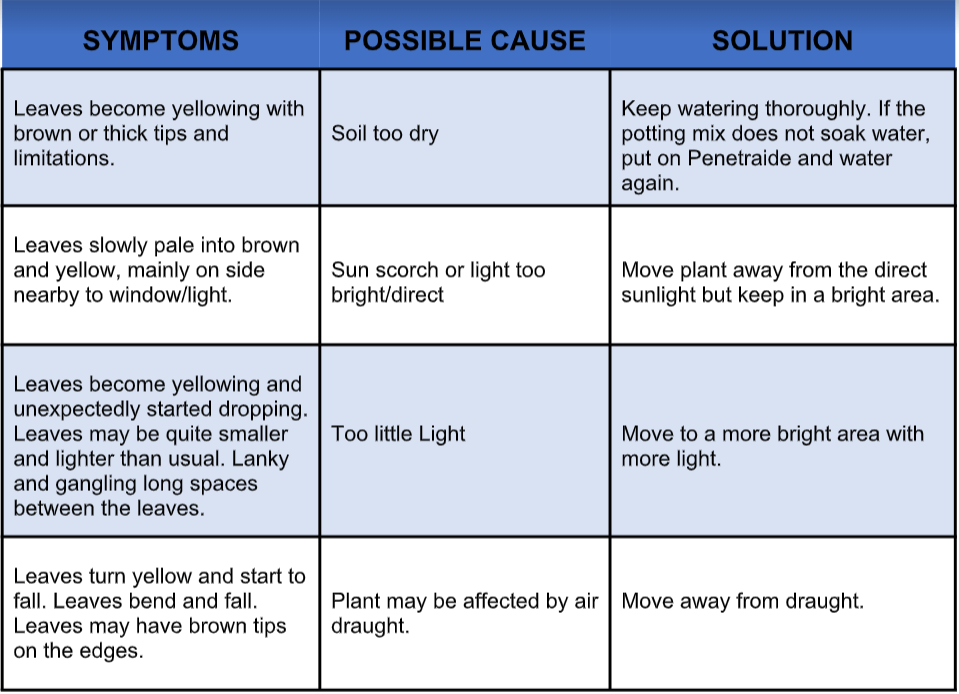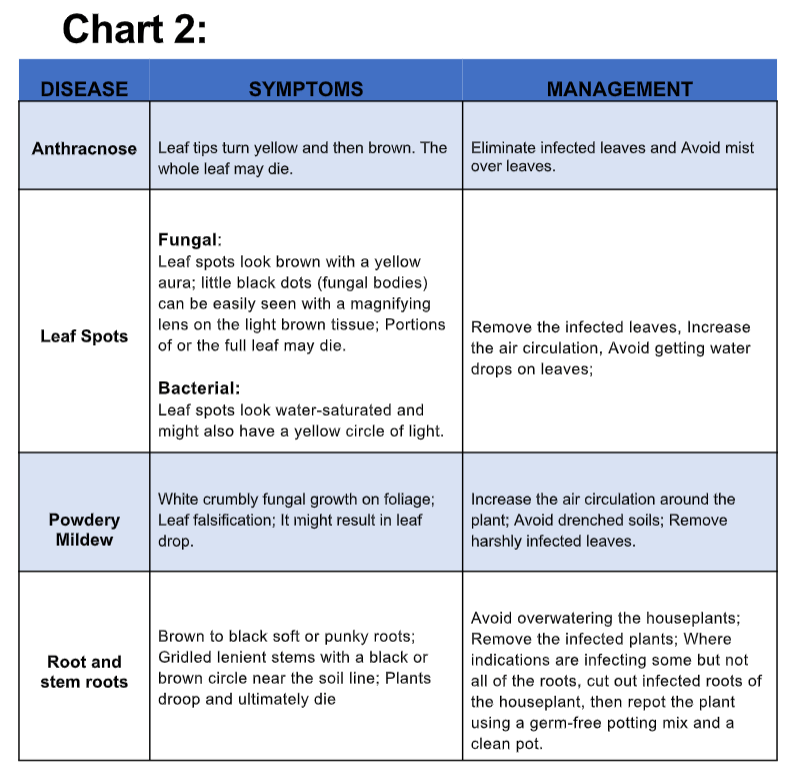HousePlantJoy is supported by our audience. When you purchase through one of our links, we may earn a small affiliate commission. As an Amazon Associate I earn from qualifying purchases. Your cost is not affected.
==================
Our Houseplant Problem Solver for Common Houseplant Problems
Turn your black thumb into a magical green thumb. By understanding the common houseplant problems, you become the houseplant problem solver. With basic knowledge of care and maintenance, combined with an understanding of the potential diseases and pests, you bring incredible greenery to your home.
Houseplants offer an easy way to reduce tension, purify the air, and add a little bit of nature into the home. Their vivid colors can lighten up an office, living room, or kitchen, while their earthy scents can soothe the space.
Yet, there is one irritating disadvantage: pests and pathogens that wreak havoc on your lovely plants. These attacks might not always be deadly, though can be. However, keeping an eye on your plants allows you to see a threat early enough to avoid severe damage.
If only you had a houseplant problem solver! Indeed, this guide will teach you about common houseplant problems and diseases, as well as ways to treat them.
Here, we are reviewing the common houseplant problems that are not actual parasitic pests. To learn about houseplant pests, please see this article.
Environment Related Common Houseplant Problems
Here are few common houseplant problems which relate to the environment. Improper sunlight, humidity, or lack of nutrients may cause these problems. With any eye toward being a houseplant problem solver, let’s have a look.
1. Yellowing Of Leaves
The leading cause of yellowing leaves in plants is overwatering. To solve the issue, give your plant a haircut and remove the yellow pieces. It could be as simple as snipping off the ends, or it could be as complicated as removing the whole leaf. If you haven’t water plants in a while, now is the time to water them.
2. Brown Leaves
Overwatering causes yellowing leaves, while under watering causes browning leaves. To keep your plant clean and strong, grab a pair of scissors and cut off any brown tips or leaves before watering it.
3. Leaning and Falling Over
The plant may be leaning or falling over due to nothing more than a lack of support. You can buy various stakes to provide more protection for your plant, enabling it to grow large and tall.
4. Pale looking Leaves
Your home may be too cold if the leaves on your plants unexpectedly drop or turn yellow. Plants can generally withstand temperature fluctuations of 5 to 10 degrees. However, anything more than that can stress them out. However, to keep your plants comfortable, keep the temperature between 60°F and 85°F.
5. Edges change color
If the ends of your plant’s leaves are rotating brown, the temperature in your home could be too hot. The plant’s lower leaves can also fall off and wilt as a result of the same problem. Make sure your home’s temperature is between 60 and 85 degrees Fahrenheit.
6. Spotty Leaves
Fungi may be the cause of spotty leaves. Spotting may cause various species reddish-brown or black spots or lesions that often run together and form larger forms. To save your vine, you’ll need to remove those leaves, which will improve its chances of recovery. Give plants plenty of room to flourish, cut dead vegetation as soon as possible. Moreover, you can water at the plant’s base to avoid disease.
7. Slow Growth, a symptom that a houseplant problem solver considers
Fungus gnats might be to blame if your plant’s growth has slowed to a crawl. There’s a fair chance there are larvae in the soil if you’ve seen some buzzing around your farm. They hatch, bind to the roots, and deplete the plant’s nutrients, resulting in sluggish growth and yellowing leaves. However, this dilemma must address as soon as possible.
8. Root Rot
Root rot causes plants to be unable to retain moisture and nutrients from the soil. Moreover, it causes them to appear dehydrated even though the soil saturates. When it comes to root rot, avoidance is certainly easier than treatment, and the only ways to stop it are good drainage and a daily watering schedule. However, if the plant can revive, remove it from the soil and give the roots a rigorous rinse.
9. Plants Become Soft
Root rot, which occurs when you overwater your plant, can cause your plant to become soft, and the leaves become mushy. Root rot can be difficult to recover from, although it is possible.
10. Dryness of plants
Under watering causes dryness and browning of plant tops, drooping of trees, lack of leaf luster. People following an inaccurate watering schedule, failing to review a plant’s exact watering needs.
Common Houseplant Problems – Care Needed
Although you can’t guarantee that you’ll be able to prevent all common houseplant diseases, you can take some precautions. On the other hand, good houseplant care practices will aid in the happiness and well-being of your plants. Cleaning up plant litter, using fresh soil and clean pruning equipment, and proper watering are all helpful in preventing disease.
Some care tips from a houseplant problem solver
1. Proper Watering
Based on how they’re grown and seasonal variations in plant growth, all houseplants have slightly different watering needs. Watering on an as-needed basis rather than on a fixed calendar schedule is preferable. One of the most frequent causes of houseplant death is overwatering. If you’re not sure how much to spray, it’s best to lean on the side of caution than to overwater your plants.
2. Propagation of Houseplant
Propagate Houseplants whenever require. Several forms of houseplants benefit from division or other methods of propagation now and then. It aids in the rejuvenation of an overgrown plant and the promotion of new growth. It’s also a cheap way to get more plants from the ones you already have.
3. Proper Fertilizing
There is no simple guideline for determining how much fertilizer to apply, just as there isn’t one for watering. It depends on the plant’s growth rate and age, as well as the season.
Many houseplants don’t need many fertilizers during the short days of fall and winter. Over-fertilizing the houseplants, like overwatering, is a bad idea. Too many fertilizers can cause their roots to burn, and their growth can stunt.
4. Remove Dust
Cleaning the houseplants improves the appearance of almost all of them. If the plants have hairy leaves, dust gathers on them, so wash them with a gentle shower of room-temperature water or dust them with a soft brush. For plants with smooth leaves, a cloth may gently clean away any dust accumulated on the leaves. It will improve the appearance of your plant and increase its ability to absorb light.
5. Repotting
Not sure if it’s time to repot your houseplants? Look at the root networks. It’s time to repot the plant if the roots are circling the interior of the jar. You should transplant the plant into a slightly larger container if it has outgrown the current container. If you want to hold it in the same tub, cut off some of the roots with a sharp knife and replant it with fresh potting soil.
6. Pruning
You can prune at any time of year, but the fall is a natural time to use your pruning scissors. The primary goals of pruning houseplants are to improve their appearance and prevent them from becoming too tall. Cutting overgrown houseplants down to 4 to 6 inches wide, similar to propagation, rejuvenates them.
Pinching refers to the removal of stem tips using fingernails or pruners. To promote the growth of the side bud, pinch out the tip of a stem and the topmost leaves.
7. Control Pests
A variety of insects often attacks houseplants. Many soft-bodied rodents, such as aphids and spider mites, can treat with insecticidal soap, a simple and inexpensive remedy. On insects with waxy coatings, such as scale and mealybugs, rubbing alcohol with a cotton ball is effective.
8. Remove Infected Leaves
As soon as diseased houseplants or infected leaves or stems appear, cut and destroy them to prevent the disease from spreading. Insects transmit viruses, but having the insect population under control will help avoid these issues. Powdery fungal leaf spots and root rot are all common houseplant diseases cause by pests.
Common Houseplant Pests Diseases
Still need help from the houseplant problem solver? consider these:
1. Sooty Mold
A fungus called sooty mold spreads on honeydew-covered plants and other surfaces. Honeydew is a sticky material produced by some insects. The name “sooty mold” comes from the fungi’s dark threadlike growth (mycelium), which resembles a layer of soot.
Although the mold will not harm the plant directly, untreated areas will allow the pores in the leaf to clog. Moreover, this disease is also slowing down photosynthesis and weakening the specimen.
Cause
Fungi spores can fall on insect excrement, causing a widespread attack that can suffocate the vegetation.
Action Required
- Prune out the worst-affected plants, such as those with mold or rodents.
- Using the fingernails or a blunt knife, scrape off the mold and rodents.
2. Southern Blight
Southern blight is a deadly fungal disease that primarily affects tropical and subtropical plants. It causes lower leaves to look water-soaked at first. Every plant component that comes into contact with the soil or is close to it may become infected.
It is a lower-leaf deficiency accompanied by root or pseudobulbar rot. After a few weeks, the stated plant sections will change color from a creamy yellow to a mushy brown look. When grown in an excessively humid atmosphere with low air circulation, white fungal growth may appear on roots.
Cause
Excess moisture between the leaves and the plant’s body is one of the causes. Poor air circulation, high humidity, and high temperatures are all factors that could hasten the process.
Action Require
- Remove any severely affected leaves from the soil line below and discard any foliar debris.
- Moreover, applying fungicides would have little effect on the fungus.
3. Powdery Mildew
Mildew is a fine white powder that can infect any part of soil above the soil surface. In more severe cases, leaves and stems can turn yellow, resulting in stunted new growth. Moreover, powdery mildew is more likely to strike specimens that are dehydrated and unfertilized.
Cause
Poor air circulation, high humidity, and moisture accumulation on the leaves or flowers are the leading causes.
Action Require
- To clear the thin layer of powder, wipe the plant with a soapy towel, paying particular attention to the foliage’s cubbyholes.
- Before you come to respray the leaves with a fungicide, wipe the plant down with a damp towel.
- Fertilizer should apply depending on the analysis of the soil test. Don’t use too much phosphorus.
- Maintain adequate air circulation around plants by spacing them properly, staking them, and controlling weeds.
4. Anthracnose
Anthracnose refers to a category of fungal diseases that cause dark lesions on leaves. Sunken lesions and cankers on twigs and stems are also possible in extreme situations.
Brown, orange, or yellow spots will appear on the leaves and scatter slowly over them, often with dark circular bands on the lesions.
Cause
Poor air conditioning, excessive moisture on the trees, and high temperatures or humidity are the leading causes. Overwatering and root rot are often associated with this condition.
Action Require
- Remove any leaves that can damage by the disease.
- Before applying a fungicide, wash the plant with an outside hose.
- Few pesticides are available to help avoid anthracnose infections, although they don’t always work.
5. Grey Mold
Grey Mold comes in two forms, one of which attacks either the flowers or the foliage. The flowers will grow small black or orange patches, while the leaves will develop small yellow lesions. Diseased debris will slip to the ground level, where it will mold and become highly contagious.
Cause
Moisture in abundance on and around the flowers or leaves can cause grey mold. Poor air circulation, high humidity, and dark environments can hasten the onset of symptoms.
Action Require
- Using a clean pair of scissors, cut any infected leaves or flowers as soon as possible.
- Take the plant outdoors and lightly mist it.
- Remove any remaining debris or severely damaged leaves, and avoid saturating the plant’s foliage at all costs.
6. Blackleg Disease
Phoma lingam, a fungus that overwinters in the dirt, causes blackleg disease in cole crops. It’s easy to spread from plant to plant, and it’s challenging to manage without good sanitation. Blackleg can affect seedlings at any point of growth, but it usually begins two to three weeks after transplantation.
Cole crop blackleg starts as small brown lesions on young plants that develop into circular areas with grey centers outlined with black dots. Young plants can die quickly as these areas expand.
Action Required
- Once either kind of blackleg has taken root, there is no suitable cure, so it’s crucial to keep it out of your garden in the first place.
- Blackleg may slow or stopped with good hygiene.
7. Phyllosticta
On the stems, tiny yellow spots will turn purple or translucent lesions. Moreover, in severe cases, the infected areas will grow elevated sandpaper-like bodies.
Cause
Poor air circulation and moisture accumulation on the leaves are the leading causes, usually accelerated by low light.
Action Required
- Using a sterile pair of scissors, inspect and clear any severely infected areas.
- Take the plant outdoors and spray it off gently.
- Keep an eye on the plant for any signs of further development.
- Remove any damaged areas or falling debris.
8. White Mold
The saprophytic fungus causes the white mold that forms on top of your potting mix. Although the fungus won’t kill the plant growing in the soil, its appearance signifies that growing conditions aren’t ideal. Moreover, it can lead to much more severe disease issues and even plant death. The fungus has little effect on the plant’s development or health until it associates with another disease.
Action Required
- You should quickly remove the moldy material off the top of the soil if the white mold makes the whole plant appear unsightly.
- Applying extra water where the top inch or two of soil gets dry is a reasonable general guideline for watering.
- Grow the plant in fresh, light-weight potting soil that drains well.
- Making a milk mist, which tends to neutralize the cottony white mold, is another natural way to eliminate houseplant mold.
9. Foliar Disease
The foliar disease is less common than root rot leaves of houseplants. However, if an indoor plant’s foliage exposes to high humidity or excessive misting, disease problems may worsen. Various foliar diseases include leaf spots, tumors, blights, and yellowing, browning, or defoliation of leaves.
Cause
Where fungal pathogen infection pressures are high, such as in humid and fertile environments
Action Require
- If the disease identifies early and diagnosed accurately, cultural methods of extracting and burning infectious material are an effective disease control.
- For certain foliar diseases, fungicides are available.
10. Rust
The leaves have brown bands or spots on them. They usually start on the underside, but they can appear on either side in later stages. Leaves will fall prematurely without yellowing first, and this often happens when you gently brush through them.
Cause
The rust fungi are a specialized group of fungi that cause rust diseases.
Action Require
- Rust is notoriously impossible to eradicate, and you will only be able to regulate it.
- In any case, gently cut the infected leaves while avoiding shaking or knocking the rust spores.
Conclusion
I hope this guide helps you regarding common houseplant problems. Please don’t give up on your houseplants, just because one or two of them have died. It’s important to remember that they’re plants. It may take time to develop your green thumb skills. However, try to figure out common houseplant problems. It’s just part of the learning process. With practice and persistence, you’ll improve your understanding of their requirements! You will be a houseplant problem solver!
May your home be filled with flourishing greenery!
Read More






